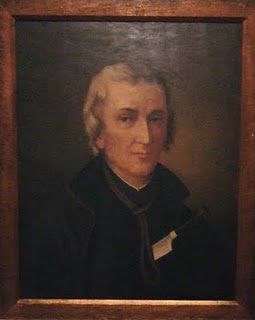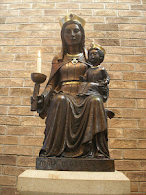 The only connection between this post and St David Lewis is the Society of Jesus. However, here in Canada’s tenth Province, I have learned some fascinating facts about Catholicism in the early days of Newfoundland. I want to share this Catholic history in the hope that you too will find it interesting.
The only connection between this post and St David Lewis is the Society of Jesus. However, here in Canada’s tenth Province, I have learned some fascinating facts about Catholicism in the early days of Newfoundland. I want to share this Catholic history in the hope that you too will find it interesting.Newfoundland was the first part of North America explored by Europeans. There are those who believe that St Brendan, the ancient Irish navigator, sailed to Newfoundland in a leather Curach in the sixth century. Five hundred years before Columbus, Vikings established a settlement at what is now L’Anse aux Meadows, in northern Newfoundland. In May of 1497, John Cabot set sail from Bristol, England and on 24th June, the feast of St John the Baptist, landed at present day Bonavista, Newfoundland. It is not known for certain if Cabot was accompanied by a priest on his voyage but it is not improbable that he was. (Some historians believe that Cabot brought Augustinians with him.) Portuguese and French explorers visited the New-Found-Land and they brought their chaplains with them to say Mass. In 1583, Sir Humphrey Gilbert took possession of the Island, claiming it for his Queen, Elizabeth I of England. He decreed that all public worship must be according to the rites of the Church of England. It was more profitable for the English Merchants if Newfoundland remained just a fishing station and those who came out to fish were compelled to return home at the end of the fishing season. For this reason, permanent settlement was not considered and hence no clergyman, Church of England or otherwise, was installed on the Island. In 1610 John Guy established the first permanent settlement in Newfoundland. He brought with him the first Protestant Minister, the Reverend Erasmus Stourton.
The first confirmed settlement of Catholics on the Island was in the 1620s at Lord Baltimore’s colony at Ferryland. Sir George Calvert, Lord Baltimore, converted to Catholicism in 1625. On 7th April 1623 he had been granted the ‘Charter of Avalon’ by King James I. The charter, which created the Province of Avalon on the island of Newfoundland, gave Baltimore authority over the territory from Ferryland to Petty Harbour.
Lord Baltimore’s dream was not to create a Catholic colony but to establish in the New World a place of religious freedom and tolerance for Catholics and Protestants. On 23rd July 1627, Lord Baltimore arrived at Ferryland. He brought with him two Catholic priests, Fr Anthony Pole (alias Smith) and Fr Longville, two Jesuits. On that very day, in thanksgiving for a safe voyage, the two priests offered Mass. Thus, less than twenty years before St David Lewis entered the Jesuit Novitiate at Sant’ Andrea, the first Mass celebrated in British North America was celebrated by priests of the Society of Jesus. Also, it was the Jesuit, Fr Anthony Pole (Smith), who was the first Catholic priest to reside in British North America. The following year, Lord Baltimore brought out his wife, Lady Joan, and all his children except his eldest son Cecil who was to remain in England to take care of affairs there. He also brought another priest, Fr Hackett S J, with him. According to complaints made by Rev Stourton, Lord Baltimore was “encouraging Popery among English subjects at Ferryland” and that Mass was celebrated there regularly “and all other ceremonies of the Church of Rome were used in ample manner as tis used in Spain.”
Unfortunately, Lord Baltimore’s colony of Avalon was short-lived. There were frequent attacks from French Privateers and Pirates and despite the fact that he and his family lived in a comfortable stone mansion, food shortages and a severe winter caused Baltimore to lose heart. Also, Lady Joan’s health was not robust so Sir George Calvert applied for a grant of land in Maryland. In 1629, Calvert (Lord Baltimore) and his family left for a more gentle climate. Calvert died before achieving his goal but his son carried on with the enterprise and took possession of what is now the state of Maryland.
In the colony of Newfoundland, no one was put to death for their faith but the harsh Penal Laws were enforced and severe penalties were meted out to Catholics and any who sympathised with them. (The only known Mass Rock outside Ireland can be found at Renews on the southern shore of the Avalon Peninsula, not far from Baltimore’s colony of Ferryland.) In 1829 the King, George IV, reluctantly gave his ascent to the Catholic Relief Act. News of emancipation reached Newfoundland in May 1829 and there was much rejoicing and celebrating in the colony. However, this joy was of short duration as on 17th December 1829 the attorney general and supreme court justices decided that the Catholic Relief Act did not apply to Newfoundland. It was May 1832 before the British Parliament finally ordered that a new commission be issued to the Island’s Governor Cochrane to remove all restrictions against Catholics in Newfoundland. Although the Catholic faith had been proscribed in Newfoundland, Catholicism had flourished and Jesuits had played a prominent part in its establishment in British North America.








.JPG)

.JPG)






No comments:
Post a Comment